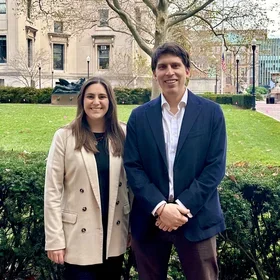By Greg Porter, '24SIPA
America’s dams are at risk of failure. This was made clear recently with the collapse of two dams in Libya in early September.
More than a decade ago, on September 11, 2012, Libya became synonymous with Benghazi in the American consciousness. Now, in the early hours of September 11 eleven years later, Libya denoted disaster once more as thousands lost homes, livelihoods, and loved ones.
A storm fed by warmer-than-average Mediterranean waters inundated the city of Derna with 16 inches of rain. Two dams, poorly maintained for years, burst, releasing a stream flow that has since been likened to a tsunami. The death toll is unprecedented—it is likely that more than 20,000 were killed.
There will be many who look at this catastrophe with a sort of aloof horror: “Yes, this is horrible, but it won’t happen here.”
It’s a lie we tell ourselves in the moments we feel unsettled.
The truth is that Libya is not that far away, for America’s dams, too, are not as sound as they once were. And just like Libya’s, they were not built for the era of increased storms and rainfall in which we now find ourselves.
In early March, the reality of this hit home for me. When California experienced its heaviest rains in years, my hometown in the southern San Joaquin Valley faced a threatening possibility: a dam breach. Pictures flooded my Facebook feed of water mere feet away from spilling over the top. People I grew up with were packing their belongings and loading their cars. Rivers I remember being bone-dry were suddenly spilling their banks. If the dam had ruptured, whole neighborhoods I knew would have been destroyed.
Thankfully, it didn’t rupture. But the close call reminded me of a sobering fact: Our infrastructure is not ready for the new world we have wrought.
My local dam was constructed in the early 1960s, but this is not an aberration—U.S. dams are practically geriatric. The average age is more than 50 years, and in California it’s more than 70 years. Seventy years ago, climate was anticipated to be stable. Sure, there would be a few odd years here and there with heavier rain and snow, but that was simply variable weather. Now, though, this same variable weather is more commonly the norm.
While it’s no secret that America’s infrastructure is in desperate need of an upgrade, there is still a tendency to believe ourselves safe. Climate change has not begun to affect all areas of the U.S., so to many eyes, it’s still business as usual. It’s easy to look at a country like Libya and chalk up its appalling catastrophe to an unstable government and its disregard for public safety.
There is truth there, but the main contributing factors are not so different from our own: The dams were old; they had not been maintained in 20-plus years; and a climate-change-induced storm caused them to finally fail.
The only news cycle most of us remember from three years ago is the pandemic. But search back to the early days of that cycle and you’ll find a frightening story: thousands in Michigan, in the throes of COVID-19, forced to evacuate their homes because of dam failures. Michigan is no stranger to rain, but a nearly century-old dam proved more of a liability than an asset. And worse yet, inspections were not sufficiently thorough, so crucial structural weaknesses were missed.
Michigan is hardly alone. Of the nearly 91,000 dams spread around the U.S., more than 15,000 are classified with “high hazard” potential. And those are just the ones that are classified. There are thousands more that haven’t been rated. In 2021, America’s dams as a whole received a D rating from the American Society of Civil Engineers. It is estimated that nearly $160 billion will be needed to repair all nonfederal dams, which make up around 95 percent of the total number of dams. Yet, President Biden’s lauded Infrastructure Investment and Jobs Act allocates only around $4 billion for dam rehabilitation.
Claudia Dreifus’s class in essay and opinion writing for the M.S. in Sustainability Management program is just one of the School of Professional Studies courses challenging students to think critically about America’s responses to climate change. Writing and reporting on these challenges to America’s infrastructure are emphasized as crucial first steps in addressing solutions to our changing world.
But when we’ve done the writing and the reporting, where do we go from there? Clearly, more needs to be done. Because what happens when we do not heed the lessons of the Libyan flood? We don’t want to be caught unawares like those thousands in Derna sleeping peacefully in the early morning of September 11.
It is not the fault of engineers from decades past that we now find ourselves in this infrastructure predicament. They did the best they could with the information they had. Now it’s time for us to do the same.
About the Program
The Columbia University M.S. in Sustainability Management program offered by the School of Professional Studies in partnership with the Climate School provides students cutting-edge policy and management tools they can use to help public and private organizations and governments address environmental impacts and risks, pollution control, and remediation to achieve sustainability. The program is customized for working professionals and is offered as both a full- and part-time course of study.


